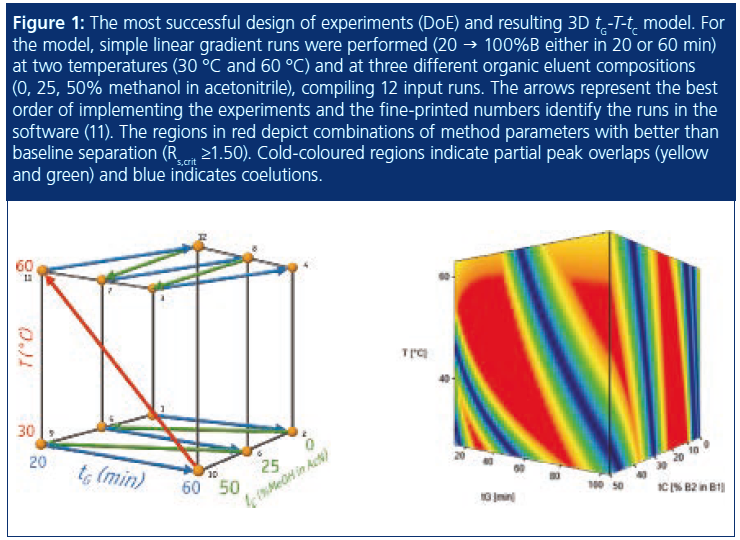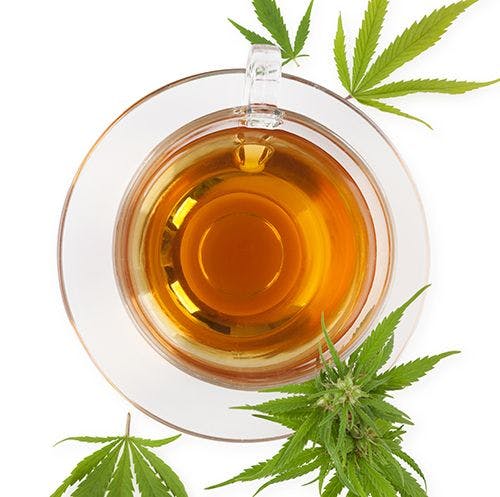Per- and Polyfluorinated Alkylsubstances (PFAS) from Dairy and Fish Using QuEChERS, SPE, and LC–MS/MS
The analysis of per- and polyfluorinated alkyl substances (PFAS) in food samples, along with an optional additional solid-phase extraction (SPE) clean-up for even more sensitive liquid chromatography tandem mass spectrometry (LC–MS/MS), is demonstrated in this article.
zi3000/stock.adobe.com
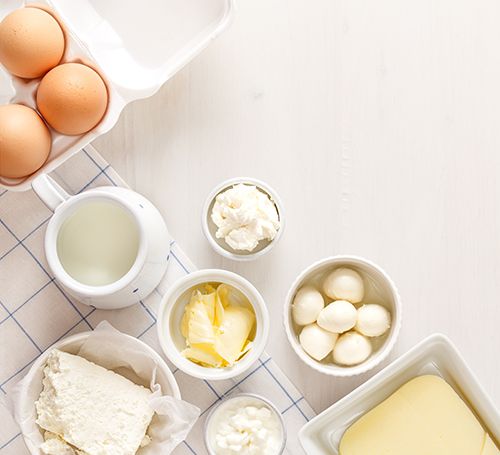
The analysis of per- and polyfluorinated alkyl substances (PFAS) in food samples, along with an optional additional solid-phase extraction (SPE) clean-up for even more sensitive liquid chromatography tandem mass spectrometry (LC–MS/MS), is demonstrated in this article.
Per- and polyfluorinated alkyl substances (PFAS) are a group of synthetic, fluorinated carbon polymers used in various commercial products, such as firefighting foams, nonstick surfaces, and food packaging. These have been detected throughout the global environment, food products, and even human plasma (1). PFAS are associated with various adverse health effects. They are bioaccumulative, ubiquitous, and their analysis level requirements are very low to account for an expected lifetime of exposure (2). QuEChERS (quick, easy, cheap, effective, rugged, and safe) is a very popular extraction and clean-up technique to analyze multiresidue pesticides in agriculture and food samples (3). Applying the same principles to overcome similar challenges in PFAS analysis in food samples, along with an optional additional solid-phase extraction (SPE) clean-up for even more sensitive liquid chromatography tandem mass spectrometry (LC–MS/MS) analysis, is demonstrated in this article.
Most of the analytical efforts have been in PFAS throughout the environment, stringent drinking water monitoring efforts, wastewater, and remediation (4). However, the estimation of PFAS exposure from food sources is rapidly increasing in food safety evaluation. Current initiatives in this area are in food contact materials, foods in regions directly impacted from environmental contamination, and certain food types that have a general increased potentiality of PFAS contamination. The 11 June 2019 press statement (5) from the Deputy Commissioner of the USFDA reaffirmed findings that did not detect PFAS in the vast majority of foods tested and that these substances do not present a food safety risk from the limited sampling study. Further research is ongoing, with these data sets as a benchmark. In the following method, sample preparation techniques using a QuEChERS extraction for dairy (milk, eggs, butter, cheese) and fish samples are explored to achieve low parts-per-billion (ppb) sensitivities, and a subsequent SPE for further sample cleanâup and parts-per-trillion (ppt) sensitivities.
Experimental
Sample Preparation: QuEChERS Extraction: One gram of homogenized sample was weighed into a 50-mL polypropylene centrifuge tube and spiked with internal standard and surrogates. A 10-mL measure of water and 10-mL measure of acetonitrile were added, followed by the QuEChERS salts (4 g MgSO4 + 1 g NaCl). The mixture was then shaken vigorously to break up any clumping, and then the subsequent slurry vortexed for 30 s and centrifuged.
After allowing the slurry to settle and separate into distinct acetonitrile, aqueous, and solid layers (Figure 1), 1 mL of the acetonitrile layer was removed for subsequent dispersive solid-phase extraction (dSPE). A 1-mL measure of the acetonitrile supernatant was then transferred to a tube containing a QuEChERS dSPE primary, secondary amine (PSA) sorbent.
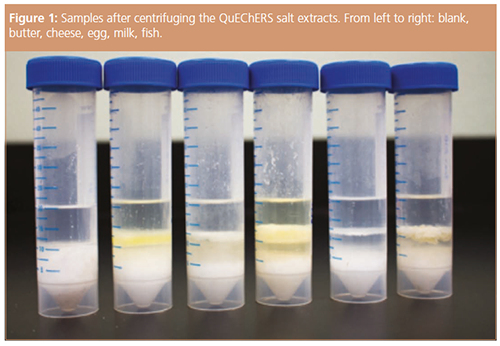
Tubes were then vortexed for 30 s and centrifuged, and 500 µL of the acetonitrile layer was transferred to a polypropylene autosampler vial for LC–MS/MS analysis, or, applied to a reversedâphase SPE procedure on a mixed-mode reversedâphase/weak anion-exchange sorbent for further matrix clean-up.
Results
The system was calibrated from 0.05 ppb (Figure 2) to 1000 ppb with a 0.05 ppb lower limit of quantification (LLOQ) and a 0.5 ppb mid-level calibrator. Butter, cheese, egg, milk, and fish samples applied to the QuEChERS extraction and dSPE clean-up achieved a 1 ng/g sensitivity (Figure 3) in their respective matrices, and 0.1 ng/g (Figure 4) with the additional SPE clean-up.
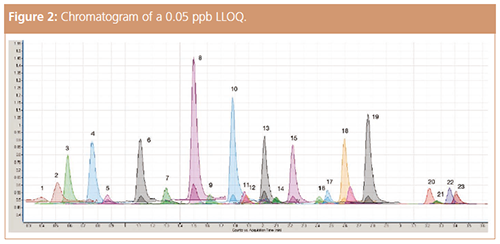
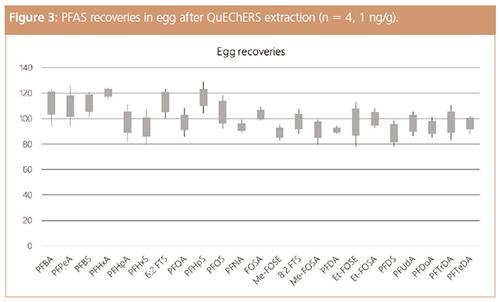
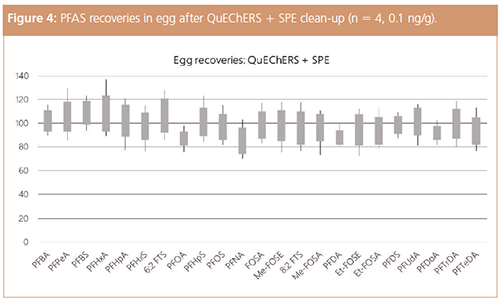
Conclusions
The modified QuEChERS method described is a very simple and effective method to determine PFAS in dairy and fish matrices, and the additional solid-phase extraction clean-up yielded even lower sensitivities that could be applied to less sensitive mass spectrometers for ppb analysis, or used for introducing less matrix to the system and reducing detector and chromatography cleaning and maintenance needs.
Even with decreased use of PFAS on commercial products, PFAS contamination will persist throughout the environment because of their bioaccumulative properties. Expanded demand for PFAS analysis to food for human consumption is increasing for food safety evaluation as a result of chronic exposure to PFAS in the environment.
Acknowledgements
Special thanks to Weck Laboratories for their contributions.
References
- H. Chang et al., Journal of Chromatography A1480, 1–10 (2017).
- R.C. Buck et al., Integr. Environ. Assess. Manag. 7(4), 513–541 (2011).
- M. Anastassiades et al., J. AOAC Int.86, 412–431 (2003).
- M.F. Rahman, S. Peldszus, and W.B. Anderson, Water Research 50, 318–340 (2014).
- www.fda.gov/news-events/press-announcements/statement-fdas-scientific-work-understand-and-polyfluoroalkyl-substances-pfas-food-and-findings
Scott Krepich is the Global Industry Manager for Food and Environmental Testing at Phenomenex, with over 20 years of chromatography experience. After studying biochemistry at the University of Illinois at Urbana-Champaign, USA, he worked as an HPLC and GC method development scientist at American Pharmaceutical Partners in Melrose Park, Illinois. Scott has been with Phenomenex for 13 years and has given hundreds of presentations and onsite demonstrations on sample preparation, chromatography, and total workflow solutions around the globe.
E-mail:ScottK@Phenomenex.comWebsite: www.Phenomenex.com
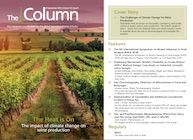
New Study Reviews Chromatography Methods for Flavonoid Analysis
April 21st 2025Flavonoids are widely used metabolites that carry out various functions in different industries, such as food and cosmetics. Detecting, separating, and quantifying them in fruit species can be a complicated process.
Analytical Challenges in Measuring Migration from Food Contact Materials
November 2nd 2015Food contact materials contain low molecular weight additives and processing aids which can migrate into foods leading to trace levels of contamination. Food safety is ensured through regulations, comprising compositional controls and migration limits, which present a significant analytical challenge to the food industry to ensure compliance and demonstrate due diligence. Of the various analytical approaches, LC-MS/MS has proved to be an essential tool in monitoring migration of target compounds into foods, and more sophisticated approaches such as LC-high resolution MS (Orbitrap) are being increasingly used for untargeted analysis to monitor non-intentionally added substances. This podcast will provide an overview to this area, illustrated with various applications showing current approaches being employed.

.png&w=3840&q=75)

.png&w=3840&q=75)



.png&w=3840&q=75)



.png&w=3840&q=75)


